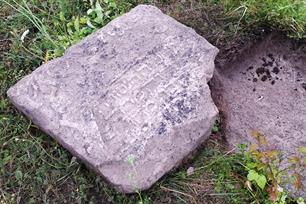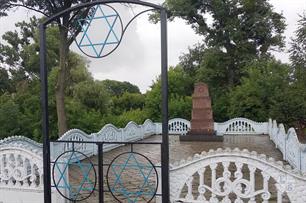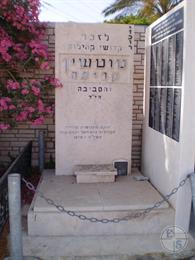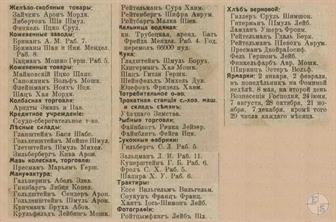Tuchyn
Rivne district, Rivne region
Sources:
- Jewish encyclopedia of Brockhaus & Efron
- Yad Vashem. Tuczyn
- The All South-Western Territory: reference and address book of the Kyiv, Podolsk and Volyn provinces. Printing house L.M. Fish and P.E. Wolfson, 1913
Photo:
- European Jewish Cemeteries Initiative. Tuchyn Jewish Cemetery
- David Shay, Wikipedia. Tuczyn and Horyngrod Jewery Holocaust memorial at Holon Cemetery
- Jewish encyclopedia of Brockhaus & Efron
- Yad Vashem. Tuczyn
- The All South-Western Territory: reference and address book of the Kyiv, Podolsk and Volyn provinces. Printing house L.M. Fish and P.E. Wolfson, 1913
Photo:
- European Jewish Cemeteries Initiative. Tuchyn Jewish Cemetery
- David Shay, Wikipedia. Tuczyn and Horyngrod Jewery Holocaust memorial at Holon Cemetery
Village, in 1940-1959 - the district center in the Rivne region. Tuchyn founded in 16 century. In the 16-18 centuries - the township of Lutsk powiat of Volyn Voivodeship as part of the Commonwealth. Since 1793 - as part of the Russian Empire. In the 19th - early 20th centuries - the township of Rivne district of the Volyn province. In 1919–39 - in the Volyn Voivodeship as part of Poland, in 1939–91 - as part of the Ukrainian SSR.
In 1847, 1180 Jews lived in Tuchyn,
in 1897 - 2535 (67,5%),
in 1921 - 2159 Jews (73%),
in 1941 - approx. 2600 Jews (including refugees).
Jews began to settle in Tuchyn in the first half of the 17th century.
In 1913, Jews owned all 3 pharmacy warehouses, all 4 wood warehouse, all 3 leather factories, all 5 cloth factories, photographer's parlor, 1 of 3 taverns, all 78 shops (including 43 grocery, 9 manufactory, 9 bakery). The Jew Freida Bat' rented an ohly mill.
The Jews were both doctors and a midwife, also a Jew was a manager in an only pharmacy.
Synagogue, Jewish nursing home and Jewish credit society acted.
In the interwar period, many local Jews made their living from trade and crafts, mostly in the clothing industry. Zionist organizations, together with their youth movements (HeHalutz, Hashomer Hatzair, Gordonia, and Beitar), were active in Tuchyn, as were the Bund and the Communists. The town had a Hebrew-language Tarbut primary school and kindergarten, in addition to a Talmud Torah and a Yeshiva.
In September 1939, the Red Army occupied the town in the aftermath of the Molotov-Ribbentrop Pact, and Tuchyn became part of Soviet Ukraine. During this period, private businesses were nationalized, and the Hebrew-language school was transformed into a Yiddish-language Soviet school. Affluent Jewish residents of Tuczyn, who were categorized as "bourgeois" by the Soviet authorities, were deported to Siberia. After the German invasion of the USSR on June 22, 1941, many local Jews fled from the town into the Soviet interior. On the eve of the Soviet-German War, Tuczyn was home to an estimated 2,600 Jews.
In 1847, 1180 Jews lived in Tuchyn,
in 1897 - 2535 (67,5%),
in 1921 - 2159 Jews (73%),
in 1941 - approx. 2600 Jews (including refugees).
Jews began to settle in Tuchyn in the first half of the 17th century.
In 1913, Jews owned all 3 pharmacy warehouses, all 4 wood warehouse, all 3 leather factories, all 5 cloth factories, photographer's parlor, 1 of 3 taverns, all 78 shops (including 43 grocery, 9 manufactory, 9 bakery). The Jew Freida Bat' rented an ohly mill.
The Jews were both doctors and a midwife, also a Jew was a manager in an only pharmacy.
Synagogue, Jewish nursing home and Jewish credit society acted.
In the interwar period, many local Jews made their living from trade and crafts, mostly in the clothing industry. Zionist organizations, together with their youth movements (HeHalutz, Hashomer Hatzair, Gordonia, and Beitar), were active in Tuchyn, as were the Bund and the Communists. The town had a Hebrew-language Tarbut primary school and kindergarten, in addition to a Talmud Torah and a Yeshiva.
In September 1939, the Red Army occupied the town in the aftermath of the Molotov-Ribbentrop Pact, and Tuchyn became part of Soviet Ukraine. During this period, private businesses were nationalized, and the Hebrew-language school was transformed into a Yiddish-language Soviet school. Affluent Jewish residents of Tuczyn, who were categorized as "bourgeois" by the Soviet authorities, were deported to Siberia. After the German invasion of the USSR on June 22, 1941, many local Jews fled from the town into the Soviet interior. On the eve of the Soviet-German War, Tuczyn was home to an estimated 2,600 Jews.
 |
 |
 |
| Jewish cemetery in Tuchyn, 2019 | Memorial in Tuchyn, 2019 | Tuchyn and Horyngrad (Krupy) Holocaust memorial at Holon Cemetery, 2009 |
The Germans occupied Tuchyn on July 6, 1941. In the same month, local Ukrainian nationalists organized a pogrom. These violent attacks claimed the lives of some 70 Jews and left many others wounded; many Jewish homes were looted. Shortly afterward, 20 Jews and 5 Ukrainians were shot as suspected Soviet activists and Communists behind the leather factory. This shooting was carried out by Einsatzkommando 4a. According to testimonies, numerous residents of Tuczyn, both Jews and non-Jews, were shot as Soviet activists in the town park during this period.
By the end of July 1941, local Jews were required to wear a Star-of-David armband, and a Judenrat had been appointed, with Getsel Schwartzman as its head. Jews were forbidden to leave the town boundaries. The community was repeatedly forced to pay ransoms in valuables and gold, and Jews were conscripted for forced labor in and near the town.
On the eve of Yom Kippur, September 20, 1942, a ghetto was established in Tuchyn. It consisted of about 50 small houses on Waskadawska Street. The inmates suffered from hunger and severe overcrowding. At about the same time, all the Jews from the surrounding area (including the town of Horyńgrуd) were also concentrated there, swelling the population of the ghetto to about 3,000 people.
On September 24, 1942, an SD unit from Riwne, which had arrived in the town, began the liquidation of the Tuchyn Ghetto, with the assistance of the German Gendarmerie and the Ukrainian Auxiliary Police. An organized resistance effort on the part of the inmates enabled as many as 2,000 Jews (including many women and children) to flee into the nearby forests.
Several hundred Jews who had remained in the ghetto were murdered there and buried outside the town, in the Kotovskiy Grove, on the road from Tuchyn to the village of Reczyca. The Germans and Ukrainian policemen soon launched a manhunt for the Jews who had escaped. Within three days, about half of them had been recaptured, and most of these were killed at the same site. According to a testimony, other recaptured Jews were killed on the outskirts of the village of Pustomyty and in the town park. Following the end of the uprising on September 26, the two leaders of the Judenrat, Getsel Schwartzman and Meir Himmelfarb, turned themselves in to the Germans, identifying themselves as the "ringleaders" of the uprising. They were executed and buried at the Jewish cemetery of Tuchyn.
In the subsequent period, several hundred Jewish escapees, mainly women and children, returned to the ghetto, having found life in the forest too hard, and trusting in the promises of the Landwirte (the senior German official of Tuchyn), who had assured them that they would not be harmed. These returnees were killed at the Jewish cemetery and in the town park several days later.
By the end of July 1941, local Jews were required to wear a Star-of-David armband, and a Judenrat had been appointed, with Getsel Schwartzman as its head. Jews were forbidden to leave the town boundaries. The community was repeatedly forced to pay ransoms in valuables and gold, and Jews were conscripted for forced labor in and near the town.
On the eve of Yom Kippur, September 20, 1942, a ghetto was established in Tuchyn. It consisted of about 50 small houses on Waskadawska Street. The inmates suffered from hunger and severe overcrowding. At about the same time, all the Jews from the surrounding area (including the town of Horyńgrуd) were also concentrated there, swelling the population of the ghetto to about 3,000 people.
On September 24, 1942, an SD unit from Riwne, which had arrived in the town, began the liquidation of the Tuchyn Ghetto, with the assistance of the German Gendarmerie and the Ukrainian Auxiliary Police. An organized resistance effort on the part of the inmates enabled as many as 2,000 Jews (including many women and children) to flee into the nearby forests.
Several hundred Jews who had remained in the ghetto were murdered there and buried outside the town, in the Kotovskiy Grove, on the road from Tuchyn to the village of Reczyca. The Germans and Ukrainian policemen soon launched a manhunt for the Jews who had escaped. Within three days, about half of them had been recaptured, and most of these were killed at the same site. According to a testimony, other recaptured Jews were killed on the outskirts of the village of Pustomyty and in the town park. Following the end of the uprising on September 26, the two leaders of the Judenrat, Getsel Schwartzman and Meir Himmelfarb, turned themselves in to the Germans, identifying themselves as the "ringleaders" of the uprising. They were executed and buried at the Jewish cemetery of Tuchyn.
In the subsequent period, several hundred Jewish escapees, mainly women and children, returned to the ghetto, having found life in the forest too hard, and trusting in the promises of the Landwirte (the senior German official of Tuchyn), who had assured them that they would not be harmed. These returnees were killed at the Jewish cemetery and in the town park several days later.

- Home
- Shtetls
- Vinnytsia region
- Volyn region
- Dnipro region
- Donetsk region
- Zhytomyr region
- Zakarpattia region
- Zaporizhzhia region
- Ivano-Frankivsk region
- Kyiv region
- Kropyvnytskyi region
- Luhansk region
- Lviv region
- Mykolayiv region
- Odessa region
- Poltava region
- Rivne region
- Sumy region
- Ternopil region
- Kharkiv region
- Kherson region
- Khmelnytskyi region
- Chernihiv region
- Chernivtsi region
- Cherkasy region
- Crimea
- Synagogues
- Cemeteries
- Objects & guides
- Old photos
- History
- Contact
Jewish towns of Ukraine
My shtetl
My shtetl
Donate
Jewish towns of Ukraine

